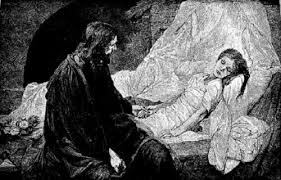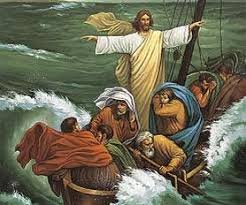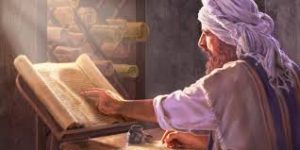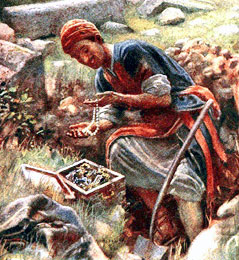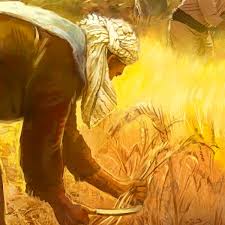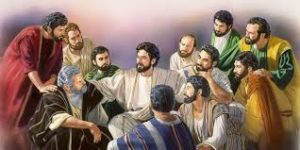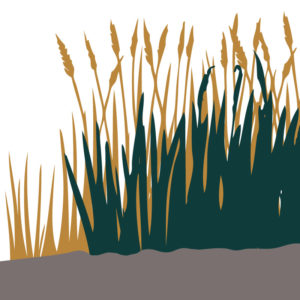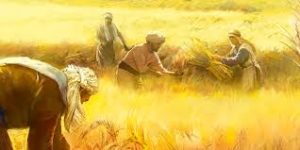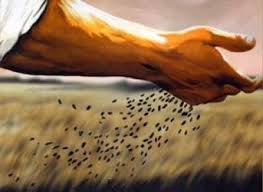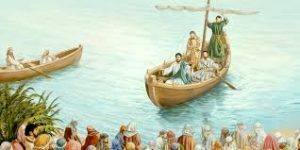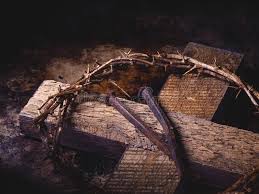Fi – Jesus Heals the Blind and the Mute Matthew 9: 27-34
Jesus Heals the Blind and the Mute
Matthew 9: 27-34
Jesus heals a blind mute DIG: What is the meaning of the title the blind men used for Jesus? How did they show faith? Why did Yeshua want them to keep quiet? How did the crowd react to Jesus’ power? How did the Pharisees react? Why the difference?
REFLECT: If we live by faith, and not by sight (Second Corinthians 5:7), in what ways might you still be partially blind or spiritually mute? How can Yeshua ben David give you fuller sight and speech?
Isaiah described the blessings that would be brought by Messiah: Then will the eyes of the blind be opened and the ears of the deaf unstopped. Then will the lame leap like a deer, and the mute tongue shout for joy. Water will gush forth in the wilderness and streams in the desert (Isaiah 35:5-6). Jesus would perform two such miracles in this day, but they would not be for the benefit of the masses. After His rejection by the Sanhedrin (to see link click Lg – The Great Sanhedrin) the focus of His ministry changed (En –Four Drastic Changes in Christ’s Ministry). The purpose of the Lord’s miracles now would be for the benefit of His apostles. Jesus knew that after His death they would be scattered and have many doubts. But He wanted them to remember his messianic miracles so as to renew their faith in Him after His resurrection.
When Messiah left Jairus’ house in Capernaum, after raising his daughter from the dead, Jesus went on from there and two blind men followed Him, calling out, “Have mercy on us, Son of David (Matthew 9:27)! The title they used is a strong messianic designation in several places in the TaNaKh (Second Samuel 7:1-16; Psalm 110), and this was the first time it had been used of Yeshua. The rabbis taught that it was a messianic term, which needed to be directed toward a descendant of King David and therefore called Meshiach ben-David, or Messiah Son of David (Tractate Sukkah 52a). The men’s request for mercy could have a two-fold meaning, both in the physical as well as the spiritual realm.755
The blind men came to the right Person, because Jesus Christ was mercy in the flesh. He was the most merciful person that ever lived. He reached out to the crippled and gave them legs to walk. He healed the eyes of the blind, the ears of the deaf, and the mouths of the mute. He found prostitutes and tax collectors and those that were corrupt and drunken, and He drew them into the circle of His love and redeemed them and set them on their feet. Never was there a person on the face of the earth with the mercy of this One.756
Before His rejection Jesus performed miracles for the benefit of the masses and did not ask for a demonstration of faith, but after, He only performed miracles on the basis of individual need and a demonstration of faith. So, the emphasis changed from the multitudes without faith, to individuals with faith. The fact that they were asking for mercy from the Savior of sinners showed personal need. But, He was not performing miracles for the masses, so He did not initially respond in public.
Somehow they were helped along and ended up at Peter’s house where Jesus was staying. At this point, Jesus only performed miracles based upon individual need. But, the miracles needed to be on the basis of faith, so He asked them the all-important question: Do you believe that I can make you see? “Yes, Lord,” they told Him, we do” (Matthew 9:28 NLT). Again they addressed Him with the messianic title of Lord.
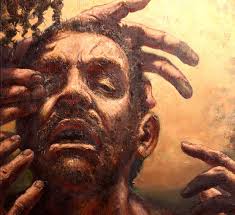
Then without the fanfare or superficial drama so common with self-proclaimed faith healers, He simply touched their eyes and said: According to your faith will it be done to you, and their sight was restored (Matthew 9:29). In the Days of Christ men learned first to believe in His Person, and then in His Word; in the Dispensation of Grace (see my commentary on Hebrews Bp – The Dispensation of Grace), we learn first to believe in His Word, and then in His Person.757
Jesus was no longer performing miracles to authenticate His messiahship to the nation of Israel, so He warned them sternly: See that no one knows about this (Matthew 9:30). But they couldn’t help themselves, and went out and spread the news about Him all over that region (Matthew 9:31). But, except for these few, the response in Capernaum was next to nothing. This only would be to their detriment.
This miracle was not only a revelation of the person of the Meshiach, for only God could restore sight to blind eyes, but also indicated what the Lord came to do for Isra’el. The Jews were spiritually blind and did not know ADONAI. Messiah came to reveal Ha’Shem to them. No one has ever seen God, but the one and only Son, who is Himself God and is in closest relationship with the Father, had made Him known (John 1:18). But, because Isra’el did not turn in faith to Him, her blindness was not removed. The light shines in the darkness, and the darkness has not overcome it (John 1:5). Even though He is the long-promised Messiah and could reveal the Father to the nation of Isra’el, there would be no benefits from His coming until the nation, as did these blind men, turn to Him in faith.758
While Jesus was leaving Peter’s house, a man who was demon-possessed and could not talk was brought to Jesus (Matthew 9:32). Being mute (Greek: kophos) often included the idea of deafness (Matthew 11:5), because the inability to speak is frequently caused by the inability to hear. In this man’s case, however, his being mute was caused because he was demon-possessed. And when the demon was driven out, the man who had been mute spoke. This was another Isaiah 35 messianic miracle.
The crowd was amazed and said, “Nothing like this has ever been seen in Isra’el” (Matthew 9:33). The reason that nothing like that had ever been seen in Isra’el was that the Messiah had never come before. He was the first one in Jewish history to do so.
But the Pharisees continued to say: It is by the prince of demons that He drives out demons (Matthew 9:34). Their hearts continued to harden toward the Son of God and His messianic claims despite all the evidence to the contrary. As the days went by their antagonism grew even more bitter. The light shines in the darkness, but the darkness has not understood (John 1:5).
“Let me explain the problem science has with religion.” The atheist professor of philosophy pauses before his class and then asks one of his new students to stand.
“You’re a Christian, aren’t you, son?”
“Yes sir,” the student says.
“So you believe in God?”
“Absolutely.”
“Is God good?”
“Sure! God’s good.”
“Is God all-powerful? Can God do anything?”
“Yes”
“Are you good or evil?”
“The Bible says I’m evil,” the student replied.
The professor grins knowingly. “Aha! The Bible!” He considers for a moment. “Here’s one for you. Let’s say there’s a sick person over here and you can cure him. You can do it. Would you help him? Would you try?”
“Yes sir, I would.”
“So you’re good . . . !” The professor thought he had him.
“I wouldn’t say that.”
“But why not say that? You’d help a sick and maimed person if you could. Most of us would if we could. But God doesn’t.”
The student does not answer, so the professor continues. “He doesn’t, does He? My brother was a Christian who died of cancer, even though he prayed to Jesus to heal him. How is this Jesus good? Hmmm? Can you answer that one?” he demanded.
The student remained silent.
“No, you can’t, can you?” the professor says. He took a sip of water from a glass on his desk to give the student time to relax.
“Let’s start again, young fella. Is God good?”
“Er. . . yes,” the student says.
The professor probed, “Is Satan good?”
The student didn’t hesitate on that one. “No.”
“Then where does Satan come from?”
The student faltered. “From God”
“That’s right. God made Satan, didn’t He? Tell me, son. Is there evil in this world?”
“Yes, sir.”
“Evil’s everywhere, isn’t it? And God did make everything, correct?”
“Yes”
“So who created evil?” The professor continued, “If God created everything, then God created evil, since evil exists, and according to the principle that our works define who we are, then God is evil.”
Again, the student has no answer. “Is there sickness? Immorality? Hatred? Ugliness? All these terrible things, do they exist in this world?”
The student squirms a little. “Yes.”
“So who created them?”
The student does not answer again, so the professor repeats his question. “Who created them?’ There is still no answer. Suddenly the professor turned to face the classroom. The class is mesmerized. “Tell me,” he continues onto another student.
“Do you believe in Jesus Christ, son?”
The student’s voice betrays him and cracks. “Yes, professor, I do.”
The old man stopped pacing. “Science says you have five senses you use to identify and observe the world around you. Have you ever seen Jesus?”
“No sir. I’ve never seen Him.”
“Then tell us if you’ve ever heard your Jesus?”
“No, sir, I have not.”
“Have you ever felt your Jesus, tasted your Jesus or smelled your Jesus? Have you ever had any sensory perception of Jesus Christ, or God for that matter?”
“No, sir, I’m afraid I haven’t.”
“Yet, you still believe in him?”
“Yes.”
“According to the rules of empirical, testable, demonstrable protocol, science says your God doesn’t exist. What do you say to that, son?”
“Nothing,” the student replies. “I only have my faith.”
“Yes, faith,” the professor repeats. “And that is the problem science has with God. There is no evidence, only faith.”
The student stands quietly for a moment, before asking a question of His own. “Professor, is there such thing as heat?”
“Yes.”
“And is there such a thing as cold?”
“Yes, son, there’s cold too.”
“No sir, there isn’t.”
The professor turns to face the student, obviously interested.
The room suddenly becomes very quiet. The student begins to explain.
‘You can have lots of heat, even more heat, super-heat, mega-heat, unlimited heat, white heat, a little heat or no heat, but we don’t have anything called ‘cold’. We can hit up to 458 degrees below zero, which is no heat, but we can’t go any further after that. There is no such thing as cold; otherwise we would be able to go colder than the lowest – 458 degrees.’
“Every body or object is susceptible to study when it has or transmits energy, and heat is what makes a body or matter have or transmit energy. Absolute zero (-458 F) is the total absence of heat. You see, sir, cold is only a word we use to describe the absence of heat. We cannot measure cold. Heat we can measure in thermal units because heat is energy. Cold is not the opposite of heat, sir, just the absence of it.”
Silence across the room. A pen drops somewhere in the classroom, sounding like a hammer.
“What about darkness, professor. Is there such a thing as darkness?”
“Yes,” the professor replies without hesitation. “What is night if it isn’t darkness?”
“You’re wrong again, sir. Darkness is not something; it is the absence of something. You can have low light, normal light, bright light, flashing light, but if you have no light constantly you have nothing and it’s called darkness, isn’t it? That’s the meaning we use to define the word.”
“In reality, darkness isn’t. If it were, you would be able to make darkness darker, wouldn’t you?”
The professor begins to smile at the student in front of him. This will be a good semester. “So what point are you making, young man?”
“Yes, professor. My point is, your philosophical premise is flawed to start with, and so your conclusion must also be flawed.”
The professor’s face cannot hide his surprise this time. “Flawed? Can you explain how?”
“You are working on the premise of duality,’ the student explains. ‘You argue that there is life and then there’s death; a good God and a bad God. You are viewing the concept of God as something finite, something we can measure. Sir, science can’t even explain a thought.”
“It uses electricity and magnetism, but has never been seen, much less fully understood either one. To view death as the opposite of life is to be ignorant of the fact that death cannot exist as a substantive thing. Death is not the opposite of life, just the absence of it.”
“Now tell me, professor. Do you teach your students that they evolved from a monkey?”
“If you are referring to the natural evolutionary process, young man, yes, of course I do.”
“Have you ever observed evolution with your own eyes, sir?”
The professor begins to shake his head, still smiling, as he realizes where the argument is going. A very good semester, indeed.
“Since no one has ever observed the process of evolution at work and cannot even prove that this process is an on-going endeavor, are you not teaching your opinion, sir? Are you now not a scientist, but a preacher?”
The class is in uproar. The student remains silent until the commotion has subsided.
“To continue the point you were making earlier to the other student, let me give you an example of what I mean.”
The student looked around the room. “Is there anyone in the class who has ever seen the professor’s brain?” The class breaks out into laughter.
“Is there anyone here who has ever heard the professor’s brain, felt the professor’s brain, touched or smelled the professor’s brain? No one appears to have done so. So, according to the established rules of empirical, stable, demonstrable protocol, science says, with all due respect, sir, that you have no brain.”
“So if science says you have no brain, how can we trust your lectures, sir?”
Now the room is silent. The professor just stares at the student, his face unreadable.
Finally, after what seems an eternity, the old man answers. “I guess you’ll have to take them on faith.”
“Now, you accept that there is faith, and, in fact, faith exists with life,” the student continues. “Now, sir, is there such a thing as evil?”
Now uncertain, the professor responds, “Of course, there is. We see it everyday. It is in the daily example of man’s inhumanity to man. It is in the multitude of crime and violence everywhere in the world. These manifestations are nothing else but evil.”
To this the student replied, “Evil does not exist sir, or at least it does not exist unto itself. Evil is simply the absence of God. It is just like darkness and cold, a word that man has created to describe the absence of God. God did not create evil. Evil is the result of what happens when man does not have God’s love present in his heart. It’s like the cold that comes when there is no heat or the darkness that comes when there is no light.”
The professor sat down. For we live by faith, not by sight (Second Corinthians 5:7).
In modern culture, this anecdote has often been popularly attributed to Albert Einstein.




